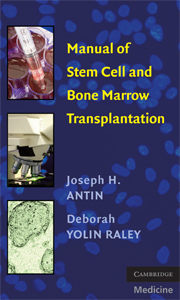Book contents
- Frontmatter
- Contents
- Acknowledgments
- Manual of Stem Cell and Bone Marrow Transplantation
- 1 Rationale for Transplantation
- 2 Types of Transplantation
- 3 HLA Matching in Allogeneic Transplantation
- 4 Stem Cell Source
- 5 Pretransplant Evaluation and Counseling of Patient and Donor
- 6 Conditioning Regimens
- 7 Stem Cell Infusion
- 8 ABO Compatibility
- 9 Engraftment
- 10 Preventative Care
- 11 Transplant-Related Complications
- 12 Graft-Versus-Host Disease – Prophylaxis and Acute
- 13 Graft-Versus-Host Disease – Chronic
- 14 Engraftment Syndrome
- 15 Infectious Disease
- 16 Graft Rejection And Failure
- 17 Gastrointestinal Complications
- 18 Pulmonary Complications
- 19 Veno-Occlusive Disease
- 20 Special Transfusion-Related Situations
- 21 Cardiovascular Complications
- 22 Neurologic Complications
- 23 Cystitis
- 24 Donor Lymphocyte Infusion
- 25 Transplantation: Regulation And Accreditation
- Appendix
- Index
20 - Special Transfusion-Related Situations
Published online by Cambridge University Press: 23 November 2009
- Frontmatter
- Contents
- Acknowledgments
- Manual of Stem Cell and Bone Marrow Transplantation
- 1 Rationale for Transplantation
- 2 Types of Transplantation
- 3 HLA Matching in Allogeneic Transplantation
- 4 Stem Cell Source
- 5 Pretransplant Evaluation and Counseling of Patient and Donor
- 6 Conditioning Regimens
- 7 Stem Cell Infusion
- 8 ABO Compatibility
- 9 Engraftment
- 10 Preventative Care
- 11 Transplant-Related Complications
- 12 Graft-Versus-Host Disease – Prophylaxis and Acute
- 13 Graft-Versus-Host Disease – Chronic
- 14 Engraftment Syndrome
- 15 Infectious Disease
- 16 Graft Rejection And Failure
- 17 Gastrointestinal Complications
- 18 Pulmonary Complications
- 19 Veno-Occlusive Disease
- 20 Special Transfusion-Related Situations
- 21 Cardiovascular Complications
- 22 Neurologic Complications
- 23 Cystitis
- 24 Donor Lymphocyte Infusion
- 25 Transplantation: Regulation And Accreditation
- Appendix
- Index
Summary
A complete discussion of transfusion reactions is beyond the scope of this manual. The incidence of infection through a blood transfusion has been greatly reduced, given the improvements in donor screening and processing techniques. The most significant infectious risk of transfusions is due to bacterially contaminated platelets. Platelets must be stored at room temperature and on an average 1 in 3,000 bags are contaminated with bacteria proven by culture. The risk of an infection through a platelet transfusion is approximately 1 in 20,000.
TRANSFUSION-RELATED ACUTE LUNG INJURY
Mechanism
The risk of transfusion-related acute lung injury (TRALI) is estimated at 1 case per 5,000 transfusions. It is characterized by acute onset of hypoxemia and the appearance of bilateral infiltration on chest X-ray within 6 hours of transfusion of a plasmacontaining product. The exact mechanism is unknown but in a subset of patients, donor antibodies (usually antiHLA) react with the recipient's white blood cells resulting in both release of intracellular inflammatory mediators and leukoagglutination in the lungs.
Differential Diagnosis
It may be difficult to distinguish TRALI from circulatory overload or adult respiratory distress syndrome.
Therapy
Care is supportive including supplemental oxygen. Approximately 75% of patients will require mechanical ventilation. Most patients will recover in 2 to 4 days; mortality rate is 5% to 10%.
- Type
- Chapter
- Information
- Manual of Stem Cell and Bone Marrow Transplantation , pp. 144 - 146Publisher: Cambridge University PressPrint publication year: 2009



